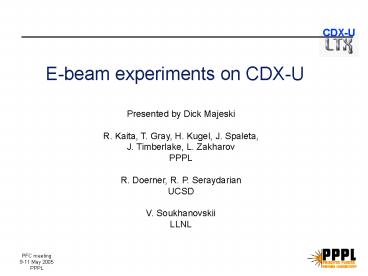Ebeam experiments on CDXU - PowerPoint PPT Presentation
Title:
Ebeam experiments on CDXU
Description:
Effects of evaporated lithium coatings. Plasma discharges with ... insulator disturbs beam. Gaussian, width = 3 mm. PFC meeting. 9-11 May 2005. PPPL. CDX-U ... – PowerPoint PPT presentation
Number of Views:38
Avg rating:3.0/5.0
Title: Ebeam experiments on CDXU
1
E-beam experiments on CDX-U
Presented by Dick Majeski R. Kaita, T. Gray, H.
Kugel, J. Spaleta, J. Timberlake, L.
Zakharov PPPL R. Doerner, R. P.
Seraydarian UCSD V. Soukhanovskii LLNL
2
Outline
- Experiments with evaporated lithium layers on
CDX-U - Electron beam implementation
- Effects of evaporated lithium coatings
- Plasma discharges with solid lithium wall
coatings - ?Solid lithium wall coatings are effective at
gettering oxygen - ?Very low recycling conditions not obtained.
- Observations on high power density e-beam heating
of thin layers of lithium - ?Demonstrated power handling of 40 MW/m2 on
static lithium may require a re-examination of
previous assumptions for the design requirements
for a lithium divertor
3
E-beam coating experiments
Axial e-beam (phase II)
Deposition monitor view (Inficon XTM/2)
Window (camera view)
- Electron gun first installed in CDX-U in March
- Differentially pumped Wilson seal - long stroke
to position over tray - Interferes with plasma must be removed
- TF VF used to guide beam (70G ea, typ.)
- Lithium tray fill used as target.
4
Radial e-beam
- Converted Thermionics e-gun
- Very simple beam optics
- 4 kV, 300 - 350 mA typ.
- 5 min. operating cycle, run at up to 50 duty
factor - Uncooled (Tantalum, Macor, SS)
Gaussian, width 3 mm
Charging of probe tip insulator disturbs beam
5
Electron beam evaporation run from 4/07/05Third
240 sec. cycle at 1.2 kW40 MW/m2Produced 1000Å
coating on deposition monitor at 0.9m
distanceViewing windows acquired opaque,
metallic coating
6
(No Transcript)
7
Plasma operations with evaporated coatings
- Procedure
- E-beam evaporation to produce a 1000 Å coating of
lithium - Measured at 0.9m with a quartz crystal deposition
monitor - Retract e-beam, switch magnet power supplies
- Setup for tokamak discharges
- Total elapsed time 15 min. until first discharge
- Time for many monolayers of surface coating on
the fresh lithium - Strong effect on vacuum conditions
- Water disappears from the RGA
- Base pressure drops by 2? (to 6-7 ? 10-8 Torr)
- Good impurity reduction, no significant particle
pumpout - Not a low recycling surface
8
Fueling comparison bare tray, hot lithium, solid
coatings
Pre-lithium (bare SS tray)
Post-lithium (liquid lithium at gt300C)
Evaporated, solid Li wall coatings
?negt (1012 cm-3)
?negt (1012 cm-3)
?negt (1012 cm-3)
3.5 1019
Particle input (from puffing). Prefill only here.
No. of deuterium atoms
Time (sec)
Time (sec)
9
Beam source design modified to permit plasma
operations with beam installed
- Axial beam orientation to allow mounting in upper
port - Beam inserted 5cm past upper vessel wall
- 5 cm behind upper rail limiter
- Guide beam to lithium with vertical field only
- 4 kV, 300 mA
10
Tray temperatures
Lithium
Movie
11
Electron beam evaporation run from 5/04 Third
240 sec. cycle at 1.3 kW40 MW/m210Å coating on
deposition monitor at 1.0m distanceNo visible
coatings on any windows
12
(No Transcript)
13
(No Transcript)
14
(No Transcript)
15
Summary
- Electron beam evaporation of lithium to produce
wall coatings was far more difficult than
expected - Entire lithium inventory is heated
- Suggests that convective heat flow completely
dominates - Wall coatings were obtained with successive
heating cycles - 1000Å at 85 cm was selected as a standard
coating - Lithium gettering produced robust, high current
discharges - Not low recycling
- Time delay may play a role
- Evaporation experiments have demonstrated 40
MW/m2 power handling capability of thin (3-4 mm)
static (i.e. no forced flow) lithium films - Tests limited only by available power density
16
Issues for static liquid metal divertors
- What is the effect of a high magnetic field?
- CDX-U coils can only operate up to 200 - 300
Gauss for long pulse - Testing at 5T is desirable, with divertor-like
field geometry - Is this power handling capability limited to
lithium? - What about tin, gallium?
- What is the peak surface temperature?
- Surface temperature distribution?
- IR camera highly desirable (slow is ok)
- How thin/thick can the layer be?
- What is the power handling limit for 100 sec
pulses? - Would a thermally controlled substrate allow for
steady state operation?































